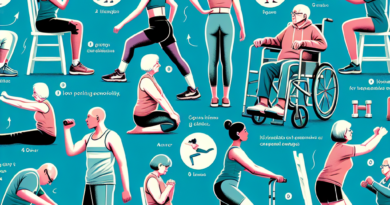Demystifying Pilates: A Comprehensive Guide for Beginners
Pilates, a physical fitness system developed in the early 20th century by Joseph Pilates, has become a popular choice for many who seek to improve their health and overall well-being. Despite its popularity, Pilates can often seem intimidating or confusing to beginners. This guide aims to demystify Pilates and provide a comprehensive introduction for those new to this form of exercise.
Pilates is a low-impact exercise method that focuses on core strength, flexibility, and overall body awareness. It emphasizes proper postural alignment, breathing, muscle balance, and smooth flowing movement. The primary aim is to strengthen the ‘powerhouse’ of your body – the abdomen, lower back, hips and buttocks.
One of the first things you should know about Pilates is that it’s adaptable to all fitness levels and needs. Whether you’re an athlete looking to enhance your performance or someone just starting on your fitness journey, Pilates can be tailored to suit your individual needs.
Pilates exercises can be performed on a mat or using special equipment like the Reformer or Cadillac. Mat-based Pilates is more accessible for beginners as it requires no special equipment other than a mat. It uses your own body weight as resistance and focuses on improving core strength and enhancing flexibility.
Equipment-based Pilates involves machines that use springs and pulleys to provide resistance. These machines allow for more varied exercises but are typically found in specialized studios.
A typical Pilates session lasts for about 45 minutes to an hour. You’ll start with warm-up exercises before moving onto a series of exercises that work different parts of your body. Each exercise is performed with attention to proper breath control and precise movements.
Breathing plays an essential role in Pilates; it helps you execute movements with power and efficiency while also promoting relaxation and focus. In general, you’re instructed to inhale deeply through the nose so that your lungs fill up completely then exhale fully through the mouth.
One of the key principles of Pilates is control. Every movement should be performed with maximum control to avoid injury and ensure effectiveness. This focus on control develops strong body awareness, improves coordination, and enhances physical grace.
Pilates offers numerous benefits including improved posture, increased muscle tone and flexibility, enhanced balance and coordination, reduced stress and tension, and boosted stamina. Regular practice can also help prevent injuries by improving body alignment and promoting more efficient movement patterns.
Before starting a Pilates routine, it’s advisable to consult with a healthcare provider especially if you have any pre-existing health conditions. Once you get the green light, seek out a qualified Pilates instructor who can guide you through the exercises correctly and safely.
Remember that like any other fitness regimen, consistency is key in Pilates. While you may not see immediate results after one or two sessions, regular practice will lead to noticeable improvements in strength, flexibility, and overall well-being.
In conclusion, Pilates is a versatile exercise system that offers numerous benefits for individuals of all fitness levels. By focusing on core strength, proper alignment, controlled movements and conscious breathing, it promotes physical strength and mental awareness. So don’t be intimidated – give Pilates a try! With patience and persistence, you’ll soon experience the transformative power of this unique form of exercise.





